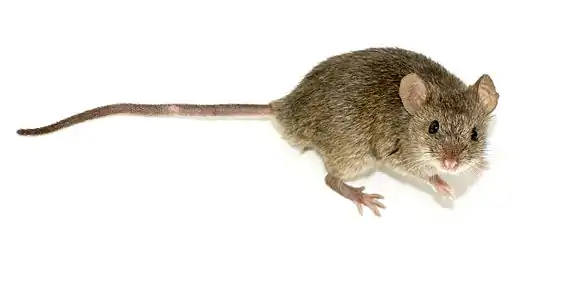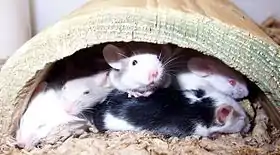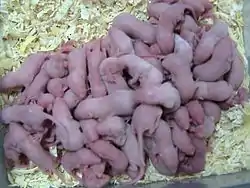Mouse
A mouse, plural mice, is a small rodent. Characteristically, mice are known to have a pointed snout, small rounded ears, a body-length scaly tail, and a high breeding rate. The best known mouse species is the common house mouse (Mus musculus). Mice are also popular as pets. In some places, certain kinds of field mice are locally common. They are known to invade homes for food and shelter.

Mice are classified under the order Rodentia. Typical mice are classified in the genus Mus.
Mice are typically distinguished from rats by their size. Generally, when someone discovers a smaller muroid rodent, its common name includes the term mouse. If it is larger, the name includes the term rat. The common terms rat and mouse are not taxonomically specific. Scientifically, the term mouse is not confined to members of Mus for example, but also applies to species from other genera such as the deer mouse, Peromyscus.
Domestic mice sold as pets often differ substantially in size from the common house mouse. This is attributable to breeding and different conditions in the wild. The best-known strain of mouse is the white lab mouse. It has more uniform traits that are appropriate to its use in research.
Cats, wild dogs, foxes, birds of prey, snakes and even certain kinds of arthropods have been known to prey heavily upon mice. Despite this, mice populations remain plentiful. Due to its remarkable adaptability to almost any environment, the mouse is one of the most successful mammalian genera living on Earth today.
In certain contexts, mice can be considered vermin. Vermin are a major source of crop damage,[1] as they are known to cause structural damage and spread disease. Mice spread disease through their feces and are often carriers of parasites.[2] In North America, breathing dust that has come in contact with mouse excrement has been linked to hantavirus, which may lead to hantavirus pulmonary syndrome (HPS).
Primarily nocturnal[3] animals, mice compensate for their poor eyesight with a keen sense of hearing. They depend on their sense of smell to locate food and avoid predators.[4]
In the wild, mice are known to build intricate burrows. These burrows have long entrances and are equipped with escape tunnels. In at least one species, the architectural design of a burrow is a genetic trait.[5]
Types of animals known as mice
The most common mice are murines, in the same clade as common rats. They are murids, along with gerbils and other close relatives.
- order Dasyuromorphia
- marsupial mice, smaller species of Dasyuridae
- order Rodentia
- suborder Castorimorpha
- family Heteromyidae
- Kangaroo mouse, genus Microdipodops
- Pocket mouse, tribe Perognathinae
- Spiny pocket mouse, genus Heteromys
- family Heteromyidae
- suborder Anomaluromorpha
- family Anomaluridae
- suborder Myomorpha
- family Cricetidae
- Brush mouse, Peromyscus boylii
- Florida mouse
- Golden mouse
- American Harvest mouse, genus Reithrodontomys
- family Muridae
- typical mice, the genus Mus
- Field mice, genus Apodemus
- Wood mouse, Apodemus sylvaticus
- Yellow-necked mouse, Apodemus flavicollis
- Large Mindoro forest mouse
- Big-eared hopping mouse
- Luzon montane forest mouse
- Forrest's mouse
- Pebble-mound mouse
- Bolam's mouse
- Eurasian Harvest mouse, genus Micromys
- family Cricetidae
- suborder Castorimorpha
Laboratory mice
Mice are common experimental animals in laboratory research of biology and psychology fields primarily because they are mammals, and also because they share a high degree of homology with humans. They are the most commonly used mammalian model organism, more common than rats. The mouse genome has been sequenced, and virtually all mouse genes have human homologs. The mouse has approximately 2.7 billion base pairs and 20 pairs of chromosomes.[6] They can also be manipulated in ways that are illegal with humans, although animal rights activists often object. A knockout mouse is a genetically modified mouse that has had one or more of its genes made inoperable through a gene knockout.
Reasons for common selection of mice are that they are small and inexpensive, have a widely varied diet, are easily maintained, and can reproduce quickly. Several generations of mice can be observed in a relatively short time. Mice are generally very docile if raised from birth and given sufficient human contact. However, certain strains have been known to be quite temperamental.
Emotions
Researchers at the Max Planck Institute of Neurobiology have confirmed that mice have a range of facial expressions. They used machine vision to spot familiar human emotions like pleasure, disgust, nausea, pain, and fear.[7][8][9]
As pets

Many people buy mice as companion pets. They can be playful, loving and can grow used to being handled. Like pet rats, pet mice should not be left unsupervised outside as they have many natural predators, including (but not limited to) birds, snakes, lizards, cats, and dogs. Male mice tend to have a stronger odor than the females. However, mice are careful groomers and as pets they never need bathing. Well looked-after mice can make ideal pets. Some common mouse care products are:
- Cage – Usually a hamster or gerbil cage, but a variety of special mouse cages are now available. Most should have a secure door.[10]
- Food – Special pelleted and seed-based food is available. Mice can generally eat most rodent food (for rats, mice, hamsters, gerbils, etc.)
- Bedding – Usually made of hardwood pulp, such as aspen, sometimes from shredded, uninked paper or recycled virgin wood pulp. Using corn husk bedding is avoided because it promotes Aspergillus fungus, and can grow mold once it gets wet, which is rough on their feet.
Diet
In nature, mice are largely herbivores, consuming any kind of fruit or grain from plants.[11] However, mice adapt well to urban areas and are known for eating almost all types of food scraps. In captivity, mice are commonly fed commercial pelleted mouse diet. These diets are nutritionally complete, but they still need a large variety of vegetables.
Mice do not have a special appetite for cheese. They will only eat cheese for lack of better options.[12]
As food

Mice are a staple in the diet of many small carnivores. Humans have eaten mice since prehistoric times. In Victorian Britain, fried mice were still given to children as a folk remedy for bed-wetting;[13] while Jared Diamond reports creamed mice being used in England as a dietary supplement during WW II rationing.[14] Mice are a delicacy throughout eastern Zambia and northern Malawi,[15] where they are a seasonal source of protein. Field rat is a popular food in Vietnam and neighboring countries.[16] In many countries, however, mouse is no longer a food item.
Prescribed cures in Ancient Egypt included mice as medicine.[17] In Ancient Egypt, when infants were ill, mice were eaten as treatment by their mothers.[18][19] It was believed that mouse eating by the mother would help heal the baby who was ill.[20][21][22][23][24]
In various countries mice are used as food[25] for pets such as snakes, lizards, frogs, tarantulas and birds of prey, and many pet stores carry mice for this purpose.
Common terms used to refer to different ages/sizes of mice when sold for pet food are "pinkies", "fuzzies", "crawlers", "hoppers", and "adults".[26] Pinkies are newborn mice that have not yet grown fur; fuzzies have some fur but are not very mobile; hoppers have a full coat of hair and are fully mobile but are smaller than adult mice. Mice without fur are easier for the animal to consume; however, mice with fur may be more convincing as animal feed. These terms are also used to refer to the various growth stages of rats (see Fancy rat).
See also
- List of fictional mice and rats
- Mousetrap
- Musophobia (fear of mice)
- Mouse brain development timeline
- Fe, Fi, Fo, Fum, and Phooey, mice who orbited the Moon 75 times in 1972 on Apollo 17
References
- Meerburg BG, Singleton GR, Leirs H (2009). "The Year of the Rat ends: time to fight hunger!". Pest Manag Sci. 65 (4): 351–2. doi:10.1002/ps.1718. PMID 19206089.
- Meerburg BG, Singleton GR, Kijlstra A (2009). "Rodent-borne diseases and their risks for public health". Crit Rev Microbiol. 35 (3): 221–70. doi:10.1080/10408410902989837. PMID 19548807.
- Behney, W. H. (1 January 1936). "Nocturnal Explorations of the Forest Deer-Mouse". Journal of Mammalogy. 17 (3): 225–230. doi:10.2307/1374418. JSTOR 1374418.
- "Mice : The Humane Society of the United States". Archived from the original on 22 January 2010. Retrieved 15 August 2016.
- Weber, Jesse N.; Peterson, Brant K.; Hoekstra, Hopi E. (17 January 2013). "Discrete genetic modules are responsible for complex burrow evolution in Peromyscus mice". Nature. 493 (7432): 402–405. Bibcode:2013Natur.493..402W. doi:10.1038/nature11816. PMID 23325221.
- "2002 Release: Draft Sequence of Mouse Genome". Retrieved 15 August 2016.
- "The facial expressions of mice". Max-Planck-Gesellschaft. 2 April 2020.
- "The face of a mouse reveals its emotions: study". Phys.org. 2 April 2020.
- "Mice have facial expressions, AI finds" (Video). Amaze Lab. 3 April 2020.
- Sharon L. Vanderlip (2001). Mice: Everything About History, Care, Nutrition, Handling, and Behavior. Barron's Educational Series. pp. 38–. ISBN 978-0-7641-1812-8. Retrieved 22 April 2013.
- "Mouse Info". Retrieved 15 August 2016.
- "Do mice really love cheese?". HowStuffWorks. 15 April 2015. Retrieved 27 February 2020.
- Flora Thompson, Lark Rise to Candleford (Oxford 1949) p. 504
- J Diamond, The World until Yesterday (Penguin 2012) p. 314
- Tembo, Mwizenge S. "Mice as a Delicacy: the Significance of Mice in the Diet of the Tumbuka People of Eastern Zambia". Archived from the original on 23 June 2008. Retrieved 13 August 2008.
- Gorman, James (19 June 2020). "Wildlife Trade Spreads Coronaviruses as Animals Get to Market". The New York Times.
- "BBC – History – Ancient History in depth: Health Hazards and Cures in Ancient Egypt". Retrieved 15 August 2016.
- Hart, George (1 May 2001). What life was like. Time Life Books. p. 40. ISBN 978-0-7370-1007-7.
- Encyc of Discovery Science and History. Fog City Press. 1 September 2002. p. 320. ISBN 978-1-876778-92-7.
- "Tour Egypt :: Egypt: A Carefree Childhood in Ancient Egypt". Retrieved 15 August 2016.
- Shuter, Jane (2003). The Egyptians. Raintree. p. 10. ISBN 978-0-7398-6440-1.
- Fontanel, Béatrice; D'Harcourt, Claire (1997). Babies: history, art, and folklore. Harry N. Abrams. p. 64.
- Colón, A. R.; Colón, P. A. (1999). Nurturing Children: A History of Pediatrics. Greenwood Press. p. 20. ISBN 978-0-313-31080-5.
- Blum, Richard H.; Blum, Eva Marie (1970). The Dangerous Hour: The Lore of Crisis and Mystery in Rural Greece. Scribner. p. 336.
- Food – Frozen mice & rats Archived 10 October 2009 at the Wayback Machine, Canberra Exotic Pets / reptilesinc.com.au, accessed 14 November 2009
- "South Florida's True Rodent Professionals". Archived from the original on 30 January 2009. Retrieved 29 May 2009.
External links
| Wikimedia Commons has media related to Mice. |
- Fancy Mice: extensive information about breeding mice and keeping them as pets
- High-resolution images of cross sections of mice brains
- History of the mouse (with focus on their use in genetics studies)
- Mouse tracks: How to identify mouse tracks
